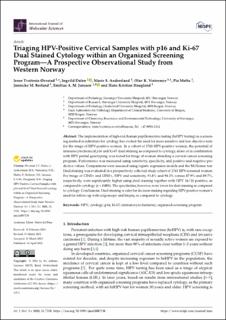| dc.contributor.author | Øvestad, Irene Tveiterås | |
| dc.contributor.author | Dalen, Ingvild | |
| dc.contributor.author | Andersland, Marie Songstad | |
| dc.contributor.author | Vintermyr, Olav Karsten | |
| dc.contributor.author | Moltu, Pia | |
| dc.contributor.author | Berland, Jannicke | |
| dc.contributor.author | Janssen, Emiel | |
| dc.contributor.author | Haugland, Hans Kristian | |
| dc.date.accessioned | 2023-11-06T14:27:42Z | |
| dc.date.available | 2023-11-06T14:27:42Z | |
| dc.date.created | 2023-06-05T13:26:03Z | |
| dc.date.issued | 2023 | |
| dc.identifier.citation | Øvestad, I. T., Dalen, I., Andersland, M. S., Vintermyr, O. K., Moltu, P., Berland, J. M., Janssen, E. A. M., & Haugland, H. K. (2023). Triaging HPV-Positive Cervical Samples with p16 and Ki-67 Dual Stained Cytology within an Organized Screening Program—A Prospective Observational Study from Western Norway. International Journal of Molecular Sciences, 24(8), 7158. | en_US |
| dc.identifier.issn | 1661-6596 | |
| dc.identifier.uri | https://hdl.handle.net/11250/3100860 | |
| dc.description.abstract | The implementation of high-risk human papillomavirus testing (hrHPV testing) as a screening method in substitute for cytology has evoked the need for more sensitive and less objective tests for the triage of HPV-positive women. In a cohort of 1763 HPV-positive women, the potential of immunocytochemical p16 and Ki-67 dual staining as compared to cytology, alone or in combination with HPV partial genotyping, was tested for triage of women attending a cervical cancer screening program. Performance was measured using sensitivity, specificity, and positive and negative predictive values. Comparisons were assessed using logistic regression models and the McNemar test. Dual staining was evaluated in a prospectively collected study cohort of 1763 HPV-screened women. For triage of CIN2+ and CIN3+, NPV and sensitivity, 91.8% and 94.2% versus 87.9% and 89.7%, respectively, were significantly higher using dual staining together with HPV 16/18 positive, as compared to cytology (p < 0.001). The specificities, however, were lower for dual staining as compared to cytology. Conclusions: Dual staining is safer for decision-making regarding HPV-positive women’s need for follow-up with colposcopy and biopsy, as compared to cytology. | en_US |
| dc.language.iso | eng | en_US |
| dc.publisher | MDPI | en_US |
| dc.rights | Navngivelse 4.0 Internasjonal | * |
| dc.rights.uri | http://creativecommons.org/licenses/by/4.0/deed.no | * |
| dc.subject | HPV testing | en_US |
| dc.subject | livmorhalsprøve | en_US |
| dc.title | Triaging HPV-Positive Cervical Samples with p16 and Ki-67 Dual Stained Cytology within an Organized Screening Program—A Prospective Observational Study from Western Norway | en_US |
| dc.type | Peer reviewed | en_US |
| dc.type | Journal article | en_US |
| dc.description.version | publishedVersion | en_US |
| dc.rights.holder | © 2023 by the authors | en_US |
| dc.subject.nsi | VDP::Medisinske Fag: 700::Klinisk medisinske fag: 750::Gynekologi og obstetrikk: 756 | en_US |
| dc.source.pagenumber | 0 | en_US |
| dc.source.volume | 24 | en_US |
| dc.source.journal | International Journal of Molecular Sciences | en_US |
| dc.source.issue | 8 | en_US |
| dc.identifier.doi | 10.3390/ijms24087158 | |
| dc.identifier.cristin | 2151876 | |
| cristin.ispublished | true | |
| cristin.fulltext | original | |
| cristin.qualitycode | 1 | |

